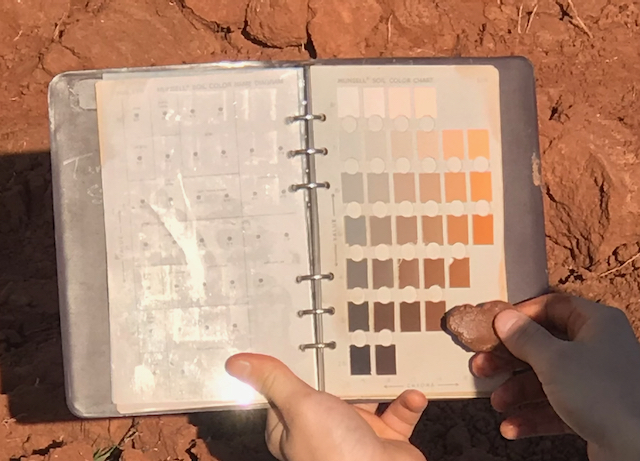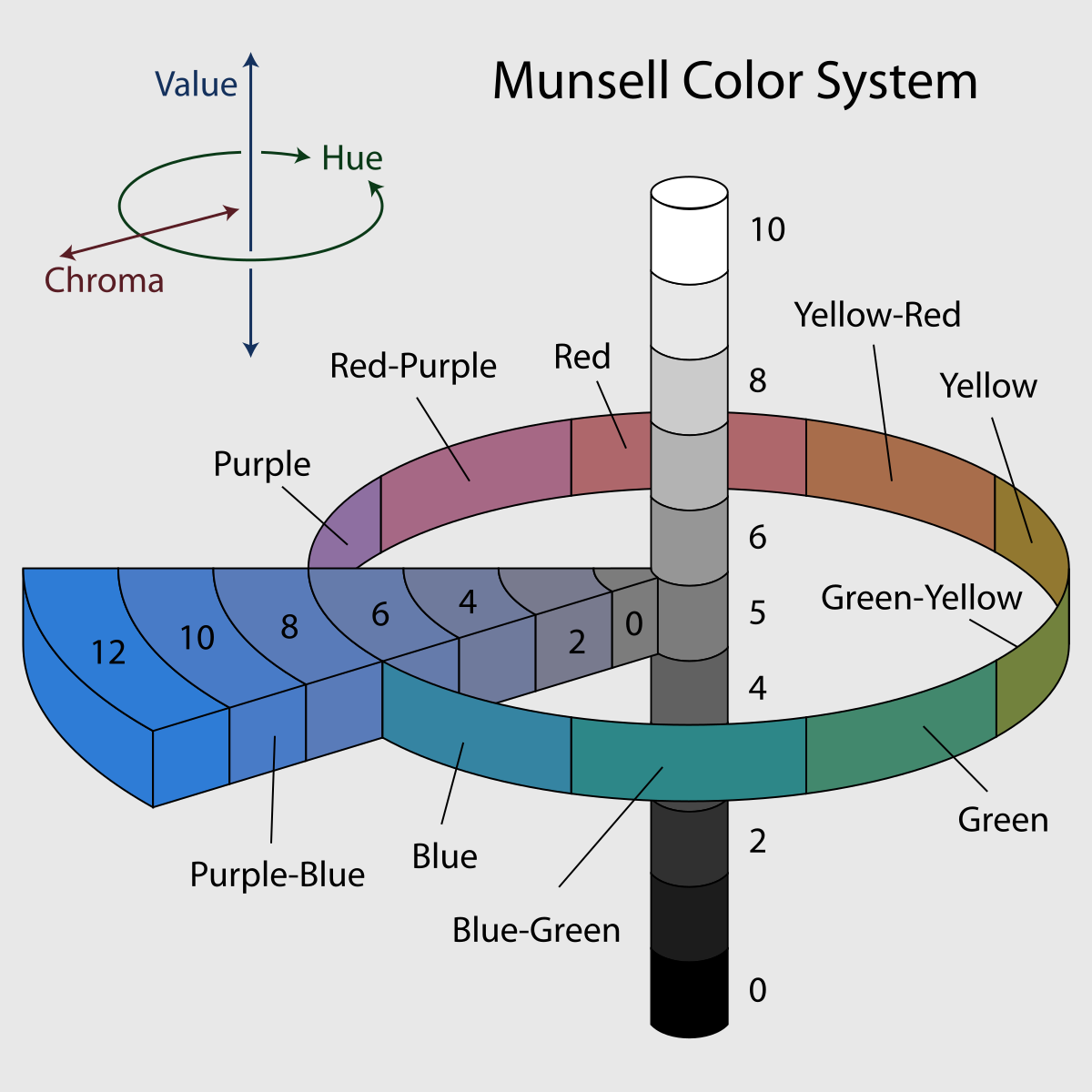Soil Color
© 2007 Donald G. McGahan (aka soilman) All Rights Reserved
Color is a physical property that has little direct effect on soil behavior beyond influencing the gain and loss of radiant energy. See also Temperature in the Climate Section.
Color is also a most obvious and easily determined soil property. Soil color is important because it is a measure, indirectly, of other important properties. Properties implied from soil color include water drainage, aeration, mineral material composition, and the organic matter content. Thus, color is used with other properties to make many important inferences regarding soil formation and land use.
Soil color is most precisely evaluated quantitatively by comparison with a reference color chart or chip. The Munsell System of Color Reporting is the reference of choice (Figure 1).

The Munsell color book consists of pages, each having color chips arranged systematically according to their hue, value, and chroma, the three variables that combine to give colors (Figure 2).

While some mineral materials colors can be telling of their elemental composition and therefore the potential to be released as nutrients to biologicals but most soil minerals are not highly colored (often light gray). It is color due to the presence of materials that coat the surfaces of soil minerals that is most often observed and recorded – or the lack thereof such as is recognized in an E Master Horizon. Thus, soil color can very helpful with meaningful predictions about soil (e.g., drainage condition, organic matter content, and relative degree of chemical weathering). Therefore, soil color is an indicator of other past and present chemophysical properties within the soil.
A notable present implication of color is albedo and the absorption energy into the soil.
- Albedo
- The percentage of diffusely reflected sunlight relative to various surface conditions Albedo (/ælˈbiːdoʊ/) (Latin: albedo, meaning ‘whiteness’) is the measure of the diffuse reflection of solar radiation out of the total solar radiation received by an astronomical body (e.g. a planet like Earth). It is dimensionless and measured on a scale from 0 (corresponding to a black body that absorbs all incident radiation) to 1 (corresponding to a body that reflects all incident radiation). (ℹ)
Typical albedo values for surface albedo are:
- forest 5–10%
- wet–soil 10%
- sand 20–30%
- grass 25%
- old snow 55%
- concrete 17–27%
- fresh snow 80%
For more on energy entering and moving in soil see Climate->Temperature.
Color: System of Reporting
The Munsell System of Color Reporting is a three dimensional notation. Hue refers to the dominant wavelength, or color of the light. Value, sometimes color brilliance, refers to the quantity of light. It increases from dark to light colors. Chroma is the relative purity of the dominant wavelength of the light (Figure 3). The three properties are always given in the order of hue, value, and chroma. In the notation, 10YR 5/4, 10YR is the hue, 5 is the value, and 4 is the chroma. This color system enables a person to communicate accurately the color of a soil to anyone in the world.
- Example:
- 10YR 5/4
- Hue = 10 YR
- Value = 5
- Chroma = 4
- 10YR 5/4
- Hue
- the spectral color or dominant wavelength (red, yellow, etc.)
- Value
- indicates its lightness (whiteness) or darkness (blackness); White = 10, Black = 0.
- Chroma
- intensity or strength of color (dilution by grey); 0 = no color, 8 = intense color

Colors and some inferences
Organic matter is a major coloring agent that affects soil color. The organic matters impact on color is dependent on its nature, amount, and distribution in the soil profile. Raw peat is usually brown; well-decomposed organic matter, such as humus, is black or nearly so. Many organic soils have a black color. This impacts the chroma and the value where increasing amounts of humidified organic matter in the soil depress the chroma (number) and to a lesser extent also depress the value (number).
The extent to which organic matter darkens soils depends upon the chemical nature of the organic material, and its form. Generally, organic matter accumulating under Grassland vegetation has the darkest color. It may cause the soil to be almost black, even when it constitutes no more than 4 to 5% of the soil by weight. The same quantity of organic matter has less of a darkening effect in forest soils. The lack of dark color is due to the specific nature of organic matter. See also the Fractionation of the Soil Organic Matter Section in Organic Matter
In most mineral soils, the organic matter content is usually greatest in the surface soil horizons and the value and chroma are lowered–in layman's terms the soil might be said to become darker–as the organic matter content increases. Many a soils A horizon do not have a black color. Black-colored A horizons, however, are common in soils that developed under tall grass on the pampa of Argentina and the prairies of the United States. An interesting color phenomenon occurs in the clayey soils of the Texas U.S.A. Blacklands. The A horizon has a black color but the black color may extend to the depth of a meter even though there is a considerable decrease in organic matter content with increasing soil depth. Other elements can pigment the soils and soils with finely divided manganese oxides contribute to the black color.
Mostly, changes in color resulting from weathering are due to the formation of secondary Fe oxides and, in some instances, Mn oxides. The distinct red, yellow, and brown colors in soils are normally attributed to the Fe compounds. The bright red color of many tropical soils is due to dehydrated and oxidized iron oxide, hematite (Fe₂O₃).Hydrated and oxidized iron, goethite (FeOOH), has a yellow or yellowish-brown color, and reduced and hydrated iron oxide has a gray color. Organic matter accumulation in the A horizons of these soils results in a brownish-red or mahogany color. Thin coatings of Fe oxides over other mineral grains may impart a light brown or buff color to the soil body. Pronounced red and yellow colors usually identify mineral substances that have been extensively weathered. Such colors are common for many tropical and subtropical soils.
Combinations of iron oxides can vary and the result is subtle but distinguishable brown and yellow-brown colors (communicated with the Munsell color notation of course!). The color is telling of processes in the soil since the iron oxide species are related to aeration and hydration conditions as controlled by the absence or presence of water. Soils on slopes that never saturate with water have subsoils indicative of well drained and aerated soil-subsoils with reddish and brownish colors. Soils in depressions that collect water, and poorly drained locations in which soils are water saturated much of the time, will tend to have gray-colored B horizons. Soils in intermediate situations will tend to have yellowish-colored B horizons. If a soil has a gray colored B horizon, the soil is likely to be water saturated at least part of the time unless it is artificially drained.
The interrelationship between color and aeration usually reflects the considerably slower diffusion of oxygen through water in the soil. Poor aeration results when pores remain water-filed for prolonged periods. When aeration is poor, Fe and Mn assume chemically reduced forms that are grayish to blue hues. Upon improvement of aeriation, Fe and Mn tend to convert to their more highly colored oxide forms. Frequently, compounds of the latter type occur as red, yellow, or brown redoximorphic feature, sometimes as streaks, within the soil, or they may form at the upper boundary of a zone saturated with water, which results in a rust colored layer lying parallel to the surface of the soil.
The light and grayish colors of E horizons are related to the elluviation (removal) of iron oxides and organic matter. Horizons in young soils may be strongly influenced by the color of the soil parent material.
Some soil horizons may have a white color. The whitest cast in arid regions soils is often indicative of accumulated lime or soluble salt accumulation at the soil surface.
An incomplete list of color inferences is offered below:
- Red: iron oxides in warm and dry environments (ferric iron is Fe3+, or Fe-III). This usually indicates good drainage. An intense red indicates a highly weathered soil.
- Yellow: iron oxides in cool and moist environments (ferric iron is Fe3+, or Fe-III). This usually indicates good drainage. An intense yellow indicates a highly weathered soil.
- Blue/Green: ferrous iron (reduced Fe2+ or Fe-II. Usually indicates poor drainage (anaerobic = no oxygen).
- Gray/White: indicates intensely leached horizons (E horizons) or poorly drained soils with Fe removed (gley).
- White: can be due to an accumulation of salts or carbonates (lime).
- Brown: usually arises from organic matter, but can also be manganese (Mn).
- Black: can be from organic matter but also could be an indication of the presence of sulfides in poorly drained soils.
Special patterns of color - redoximorphic features (perviously called mottles)
Redoximorphic features are spots, or patches, of different color or shades of color interspersed with the dominant color can be from redoximorphic conditions and these would indicate alternating periods of good drainage with poor drainage.